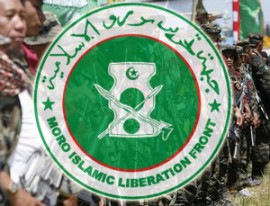The decades-old armed conflict in the large southern island of Mindanao reared its head again when an army patrol was ambushed there recently, resulting in the death of 19 soldiers. Some of the soldiers were tortured first and then beheaded or dismembered.
Immediately, howls of outrage rang in this capital and elsewhere, demanding retaliation by the government. Hotheads called for an “all-out war” against the  (MILF), whose members allegedly perpetrated the treacherous ambush.
(MILF), whose members allegedly perpetrated the treacherous ambush.
Many Filipinos raged against the Moros. A great number of those calling for war called the Moros, a Muslim minority in southern Philippines, evil names. Even a military spokesman publicly called for the cessation of the “peace” talks currently under way between the government and the MILF, earning for himself a sacking by his superiors. There was tension and anger across the nation.
President Benigno Aquino III remained cool-headed in the midst of the agitated state of the populace. He spurned the calls for an all-out war. He bade the people to be calm and called for a sober analysis of the tense situation. He wanted the peace talks to continue. He, instead, favored a policy of “all-out justice” toward the Moros.
Most Filipinos found the President’s stance ambiguous and accused him of merely sloganeering. But in a matter of a few days, Aquino’s “all-out justice” became evident to the people. Mr. Aquino ordered the military to go all-out after the soldiers’ killers, pursuing them into the jungles of Basilan province where the perpetrators supposedly took refuge. Soldiers attacked suspected strongholds of the MILF and army planes bombarded the territory.
As of this writing, an MILF camp is said to have been taken over by the military and soldiers are still in pursuit of the ambushers.
The MILF is a secessionist rebel group calling for the creation of a Moro “sub-state” in Mindanao. The Philippines being a predominantly Catholic country, the Muslims in Mindanao have always felt detached from mainstream Philippine affairs.
Mindanao is physically far from Manila, where the central government is located. Aside from physical distance, the difference in religions has separated the Muslims spiritually from the rest of the population (there are other, smaller religions but the Catholics account for about 80 percent of the people). Many Mindanaoans claim that politically and in appointive positions, they are underrepresented in government. Alienation, resentment and suspicion have dominated Catholic-Muslim relations.
For these reasons, the Moros (Muslims) have been agitating for independence for several decades now. The national government has not granted the Moros’ petition because that would result in the loss of a huge chunk of the country’s territory.
Mindanao is a vast, fertile land with limitless economic potential. It is the second-largest island in the nation, next to Luzon in north Philippines. The big island is host to large swaths of plantations planted to pineapple and other important crops and timber. The seas that surround it teem with tuna and other sought-after species of fish that go to dinner tables in the country and, important for their foreign-exchange value, abroad (mainly Japan and the United States). The island also has factories for various products and raising grounds for livestock that contribute to the country’s gross domestic product.
In short, Mindanao is undoubtedly a productive and important part of the Philippines. Its long-term potential is barely scratched at the surface.
But it’s wracked with this long-time dilemma of secessionist fever that has stunted its economic, political and human-resource growth. What is the government to do?
Peace talks have been undertaken by practically all previous governments but still, the problem remains unresolved. Military force has also been brought to bear on the rebellious Moros over the years, but without lasting success, harmony or unity. It’s a conundrum that may not have a negotiable solution. It’s been festering for decades and may remain so for decades more. It’s worth noting that the Americans, who took over from the Spaniards as the Philippines’ colonizers at the turn of the 20th century, were never able to subdue the Moros of Mindanao. And the Spaniards failed to “Christianize” the Moros.
The Moros, for reasons cited above, including their perceived neglect by the central government, have wanted to secede from the nation for years. The national government and the Filipino people as a whole, have rejected this clamor for independence. The Moros have achieved a form of autonomy but this experiment is perceived as a failure, mainly because of failure of government, with the local people running the region turning out to be corrupt and incapable of any viable and effective form of public administration.
Thus, factions of the Moro population have taken up arms to get what they’ve been unable to win politically.
The peace negotiations are continuing but offer not even the faintest glimmer of hope that something mutually acceptable, viable and beneficial will result from them. The quandary remains.
And as the impasse prevails, armed fighting continues between the rebel and government sides. Lives are lost every day, including and most sadly, civilians who are caught in the crossfire. Economic resources are wasted or unused because of the conflict. Peace and order is tenuous. Corruption is rampant, although the national government has high hopes that new elections in 2013 will produce more competent and earnest public servants in the region.
For now, Mindanao remains a land in turmoil, its people caught on the horns of a dilemma, and its vast potential unfulfilled. The conflict there will reap its grisly toll of unwanted deaths, on both sides, while the negotiators toil to come up with a just and lasting resolution.
It’s disheartening to say, but the wait could still be a long one.
Iconic One Pro Theme | Powered by Wordpress
